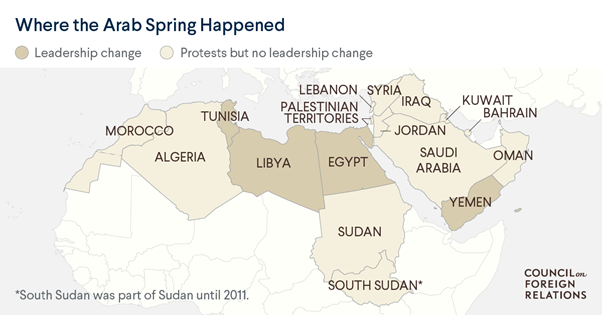What became of the ‘Arab Spring’?
- Posted By
10Pointer
- Categories
World Affairs
- Published
26th Jul, 2022
-
Context
Recently, Tunisian President is set to secure more power under a new constitution that is expected to pass in a referendum.
What was the Arab Spring?
- The name ‘Arab Spring’ is a reference to the Revolutions in 1848 when political upheavals swept Europe.
- The Arab Spring was a series of pro-democracy uprisings that enveloped several largely Muslim countries, including Tunisia, Morocco, Syria, Libya, Egypt and Bahrain.
- The events in these nations generally began in the spring of 2011, which led to the name.
- However, the political and social impact of these popular uprisings remains significant today, years after many of them ended.
- When protests broke out in Tunisia in late 2010 and spread to other countries, there were hopes that the Arab world was in for massive changes.
- The expectation was that in countries where people rose, such as Tunisia, Egypt, Yemen, Libya, Bahrain and Syria, the old autocracies would be replaced with new democracies.
- But Tunisia is the only country where the revolutionaries outwitted the counter-revolutionaries. They overthrew Zine El Abidine Ben Ali’s dictatorship, and the country transitioned to a multi-party democracy.
- But except Tunisia, the country-specific stories of the Arab uprising were tragic.
Features
- The Arab uprising was originally triggered by a combination of factors.
- The economic model based on patronage was crumbling in these countries.
- The rulers had been in power for decades, and there was popular longing for freedom from their repressive regimes.
- More important, the protests were transnational in nature, though the targets of the revolutionaries were their respective national governments.
- The driving force behind the protests was a pan-Arabist anger against the old system. That’s why it spread like wildfire from Tunis to Cairo, Benghazi and Manama.
- They may have failed to reshape the Arab political order, but the members of the uprisings appear to have survived the tragedy of ‘Arab Spring’.
Arab Spring Movements
- Jasmine Revolution in Tunisia
- A street vendor immolated himself against mistreatment of local officials.
- Protests followed throughout the country.
- President Zine el-Abidine Ben Ali fled the country.
- Later, a democratically chosen President and Prime Minister took office.
- Revolution in Egypt
- Young Egyptians protested through social media following Tunisian protests.
- The Egyptian army refused to use force against protesters.
- President Hosni Mubarak left office.
- Military enjoyed a high public approval in the interim before a new government.
- Other Countries
- Encouraged by Tunisian and Egyptian protests, Yemen, Syria, Bahrain and Libya held demonstrations.
- Unlike Tunisian and Egyptian, the struggles between opposition and ruling regimes turned bloody and violent.

